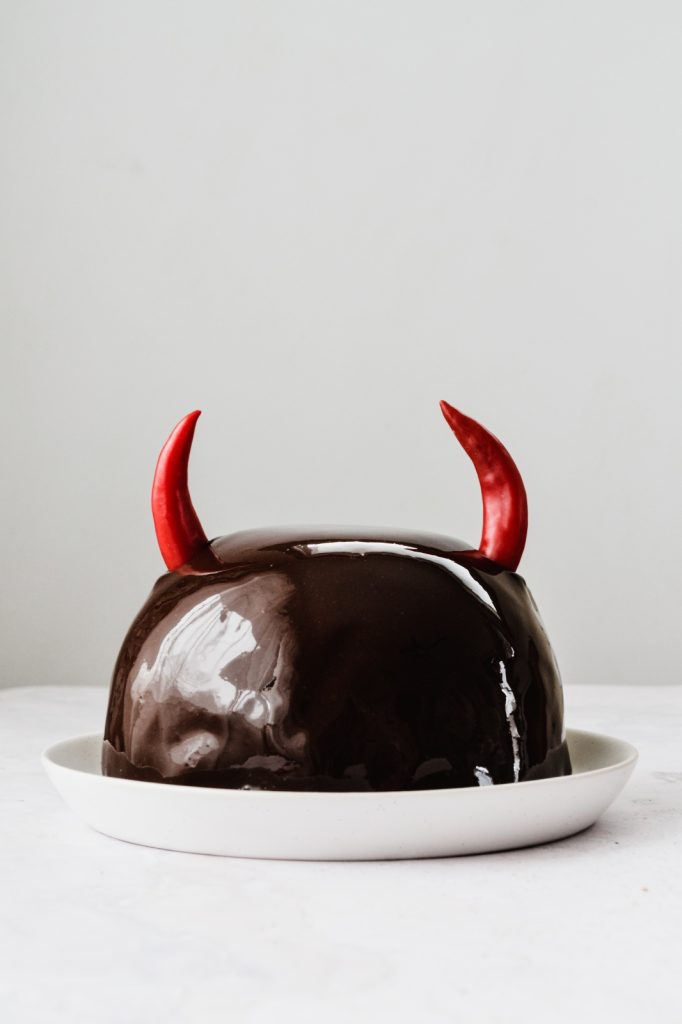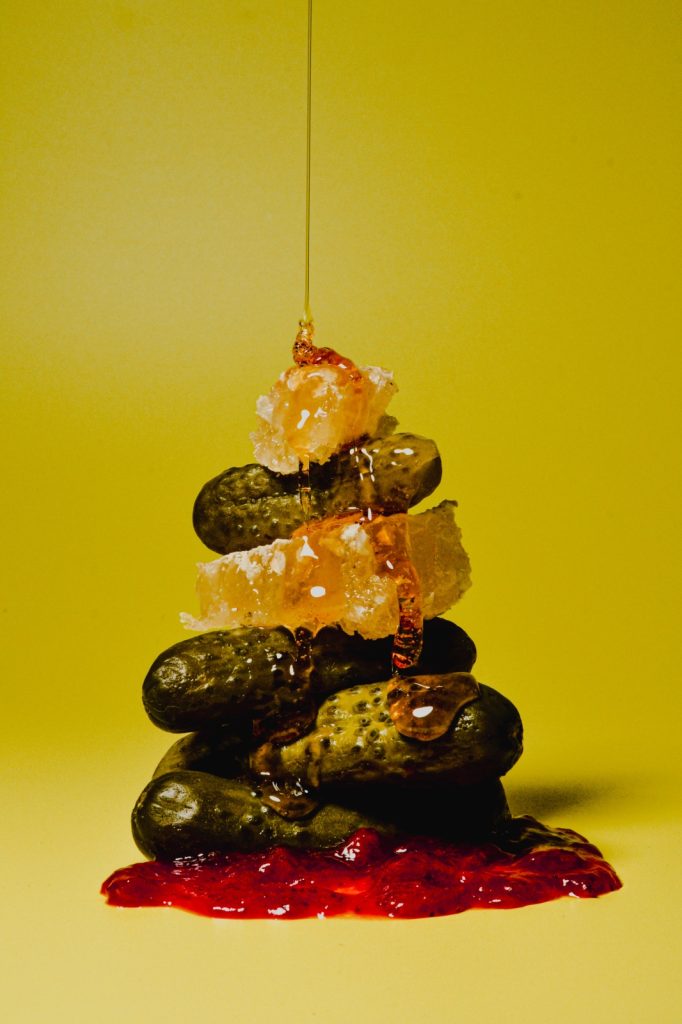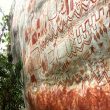
Dartmouth Halifax-based artist Emily Lawrence posted Aquarius Dessert on her Instagram (@emilylawrenceca) on February 1, 2021. An elegant, salted crème brûlée dessert is pictured like a dancer in a white fluted bowl situated slightly off centre on a white ground. Golden candied hazelnuts rest like fallen stars on the flame-crusted sugar surface of the brûlée, each piercing sugar-crystal tail tapering upward to support a dramatically suspended ethereal cloud of sunshine spun sugar. Underneath the image, in the thoughtfully crafted caption, Lawrence expounds this dessert in the style of a monthly horoscope forecast: “A cold-to-the-touch dessert enrobed by a thick, salty crust allows the Aquarian to enjoy a bit of smashing, like they would systems of belief or oppression. … Much like their out-of-the-box thinking, the caramel doesn’t just lie on the surface, candied hazelnuts reach up towards a spun sugar cloud where visionary brilliance can run free. …”
Aquarius Dessert is the first installment of the Zodiac Desserts (2021–2022) series. Born from the darkest days of the COVID-19 lockdowns, the Zodiac Desserts series was a project with specific parameters—a dessert dreamt up, crafted, styled, and photographed every month to symbolize the corresponding sign of the zodiac. For Lawrence, the project was intended to be an imaginative offering to create connectivity for herself and others during prolonged periods of isolation. The Zodiac Desserts encouraged Instagram scrollers to identify with the desserts themselves, or to tag friends who are “bold and ambitious” Aries, like peanut butter and jam bombe cakes with amber rum flambéed meringue, or “centre-of-the-universe” Leos, who are like a vanilla bean and sunflower seed butter crème diplomat filled “croquembouche personified.”
While Lawrence lets scrollers know that they can find the full recipe for each extravagant dessert on her website, she is not imagining desserts that will taste the best, nor is she creating dishes that scrollers will find easy to make. Lawrence notes affably, “Is there a more delicious ice cream sandwich combination than the cucumber mint ones in the Gemini Dessert? Absolutely. Is a mushroom flavoured meringue from the Taurus Dessert the best flavour imaginable? Absolutely not. For me, the concept and clever combinations is the most important part. That said, I would never compromise taste.” In Zodiac Desserts, Lawrence makes fantasies out of sugar, butter, flour, and dreams.

At the same time as she was beginning to post the Zodiac Desserts, Lawrence shared on Instagram another series about food fantasies, further utilizing social media as a platform for connection and engagement when it was not possible to visit galleries or meet in person. Kids’ Menu (2021) is a series of photographs of outlandish and over-the-top culinary creations inspired by children and youths’ “dream meals.” A year earlier, in the first months of the pandemic lockdown, Lawrence circulated a playful worksheet for kids to fill out with their caregivers, asking them questions about their favorite flavours and foods, inviting them to imagine and then describe and draw their dream meal. These meals could be anything and were without constraints—there was no limit of stomach capacity, budget, or availability. Lawrence worked to make these dreams material with fantastical results. Imagine pancake soup featuring toasted mini-pancakes floating in milk, a parfait of dill pickles with honeycombs and strawberry jam, goldfish crackers swimming in sparkling “spicy” water, and decadent mac and cheese cupcakes, to name only a few. Lawrence understands that for many people “foods containing super-sized doses of sugar, fat, and bright colourant elicit a deeply rooted physiological magnetism.” With this project, Lawrence tapped into the unfettered culinary imagination of young minds that are often less restrained by decorum and entrenched moralizing social messages surrounding food, eating, and bodies.
While the Zodiac Desserts present fantasies of foods that look too good to be true (and often are), Kids’ Menu serves enchanting culinary misfits that are surreal phantasmagorias that would probably taste too weird to be yummy. Here I return to my earlier point that Lawrence is not designing and crafting foods that are meant to be “real”—dishes and recipes that are actually functional (delicious, easy to make) or accessible (inexpensive, not too time consuming, not requiring special tools or skills).
In this way, Lawrence subverts the expectations of Instagram scrollers used to engaging with the carefully curated visual culture of food, cooking, and eating posted by food and lifestyle influencers that are trying to sell scrollers cookbooks, products, events, or other branded goods. Lawrence’s artworks presented on Instagram are a significant departure from the majority of foods and recipes posted on social media platforms in that she is not selling anything. Generally, influencers specifically design recipes to make intricate meals easy, affordable, quick, and, above all else, tasty, claiming to make the inaccessible fancy cuisine of gourmet cooking a reality for the untrained everyday person who is working with ingredients they can pick up from a common grocery store. Lawrence is instead materializing food dreams that she hopes people will connect with deeply in their bodies and their imaginations.
Lawrence’s food-based practice aims to tap into feelings of desire, pleasure, wonder, and wellbeing that smelling, tasting, feeling, and looking at food can elicit. By unabashedly revelling in the bodily delight of foods in these two projects, Lawrence offers scrollers an island of reprieve amongst the food-shaming and fatphobic blur that is much of the food culture on the internet. As I scroll Instagram today, so many posts about food, eating, and bodies centre shaming and moralizing rhetoric (“losing the pandemic 20!,” “guilt-free foods for treat days!,” and “eating clean!” are some examples). I want to be clear here: food is absolutely a political and moral issue. Who can afford restrictive diets based on fresh produce and meat? Who has the time to cook food from scratch? Where is food in local grocery stores coming from and what are the labour and environmental practices in those places? Who can afford to live close to a grocery store? Who is centred by the colonial and White supremacist standard of the beauty industry that demands mandatory thinness? Why are people killing themselves (literally) to be thin? Why are fat people cast as moral deviants (lazy, greedy, slovenly, unrestrained, undisciplined, weak, stupid, unable to care for themselves)? In this world, celebrating the embodied joy and pleasure of eating, and the beauty and glory of food is a radical political act. For me, Lawrence’s food-based art projects set me free. They give me permission to get a bit freaky in my frying pan (maybe I’ll add this weird star shaped fruit to my stir fry?) and approach everyday meals as a playful event (perhaps I’ll have a whole purple-themed picnic?). There is something beautiful and powerful about making our own dreams come true each day in the bites we make and take.
















Leave a Reply